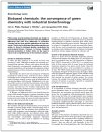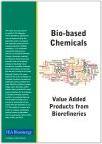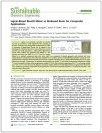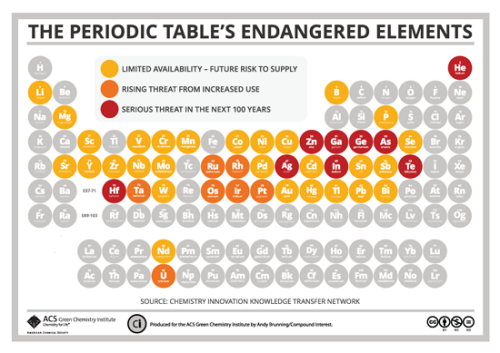Endangered Elements
What are Endangered & Critical Elements?
Of the 118 elements that make up everything—from the compounds in a chemist’s arsenal to consumer products on the shelf—44 will face supply limitations in the coming years. These critical elements include rare earth elements, precious metals, and even some that are essential to life, like phosphorus.
Download a high resolution image of the Periodic Table's Endangered Elements [PDF]
How Do Endangered & Critical Elements Relate to Green Chemistry?
Endangered elements in the chemical enterprise face critical supply risks, making sustainable management of their extraction, use, reuse and dispersion essential. In addition to the environmental cost of extracting and processing endangered elements, there is, for some of these materials, an additional human cost of conflict minerals mined to finance armed disputes. Research into more abundant alternatives, more efficient uses, recycling and recovery will help mitigate risks and move industry towards sustainable supply chains.

Focus Principles
- Use of Renewable Feedstocks - Ideally, we would use only raw materials and feedstocks that are renewable rather than depending on and depleting finite resources like the “endangered elements.”
- Maximize Resource Efficiency – Knowing that resources in the earth’s crust are limited, green chemists can design products that use abundant materials and that can be easily recycled.

Examples of Reducing Dependence on Endangered & Critical Chemicals
While not yet commercially implemented, recent research has investigated the use of graphene and carbon nanomaterials as a substitute for scarce materials in a variety of applications. Scientists at Chalmers University, for example, identified 14 metals whose use could be significantly reduced if replaced with carbon nanotubes. There is a growing body of research that indicates significant potential for graphene-based catalysts to replace, or at least minimize, our dependence on platinum, palladium, rhodium and other endangered elements.
Another active area of research is biocatalysis. In some cases, such as in fuel cells and electrocatalysis, bacterial enzymes have shown potential as replacements for critical materials.

A Closer Look at Endangered & Critical Elements
Select an element below to learn more about the availability, properties and global impact of the specific element. Check back as new elements are added to the site:
Additional Resources & Literature on Critical Elements
-
Helium Shortage to Occur in the Next 25-50 Years (The Nexus, 2017)
Iridium: An Amazingly Useful Element, but at What Cost?? (The Nexus, 2017)
Innovation and Opportunity: Seeking Uncommon Solutions in Rare Earths (The Nexus, 2016)
Chemistry and Systems Thinking (The Nexus, 2016)
Message from the Director: Critical Materials and Endangered Elements (The Nexus, 2014)
The Periodic Table’s Endangered Elements (Infographic)
Outsmarting the Shortage: the Emergence of Base Metal Catalysis in Pharma (Webinar)
-

Report on Critical Raw Materials for the EU (2014)
This report examines materials of high economic importance and high supply risk to the EU. Of 54 candidates, 20 materials are identified as critical.
Annex to the Report on Critical Raw Materials for the EU (2014)
An annex to the above report published by the European Commission with statistics and data on the identified critical raw materials.
5th Chemical Sciences and Society Summit (CS3) 2013 Whitepaper: Efficient Utilization of Elements (2013)
This whitepaper provides an overview of the main elements facing supply restrictions and research areas of importance, with recommendations. This includes materials for energy production, catalysis, and reuse and recovery.
Element Recovery and Sustainability (2013)
This book addresses the economic, political, and research challenges presented by the limited global supply of rare earth elements and precious metal. Chapters focus on recovery methods and are drawn from the chemistry, engineering, and biotechnology sectors.
Energy Critical Elements: Securing Materials for Emerging Technologies (2011)
This report published focuses on materials used in new technologies that face future supply constraints. It also outlines steps the U.S. can take to mitigate this risk.
This research was conducted by the Chemical Innovation Knowledge Transfer Network.
ACS GCI's Green Chemistry and Engineering Conference
The 28th Annual Green Chemistry & Engineering Conference will be held June 2-5, 2024 in Atlanta, Georgia, with the theme AI-Generated Green Chemistry.


